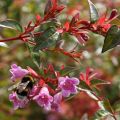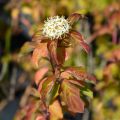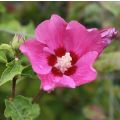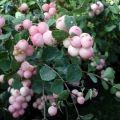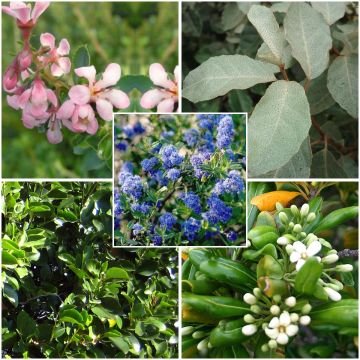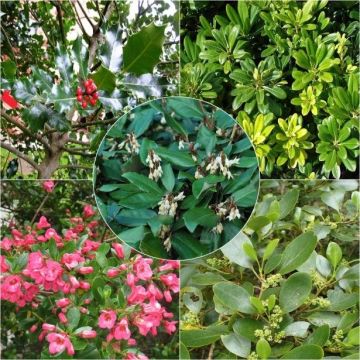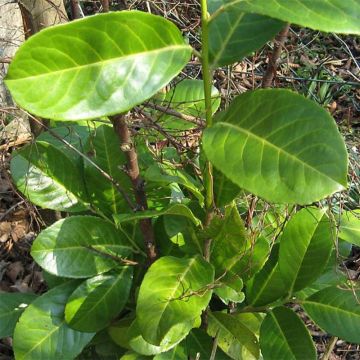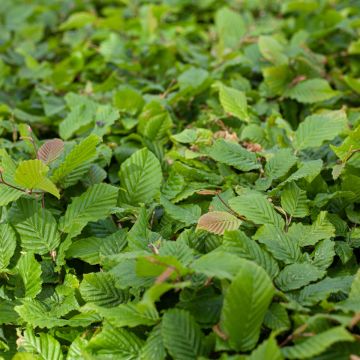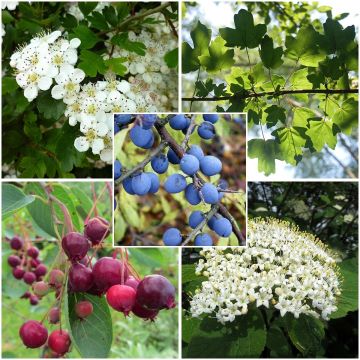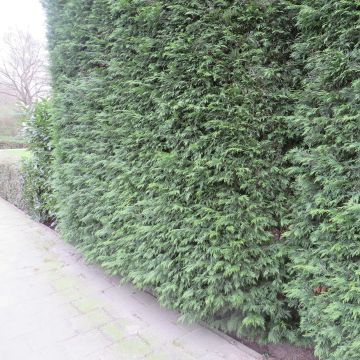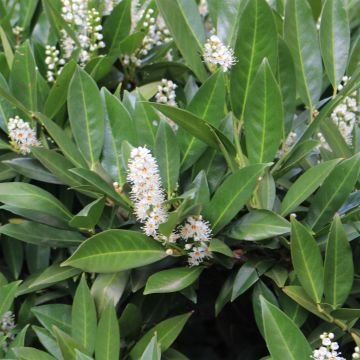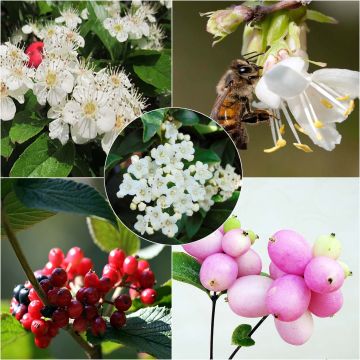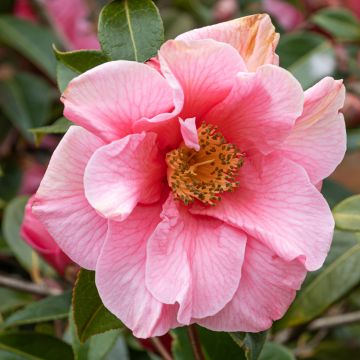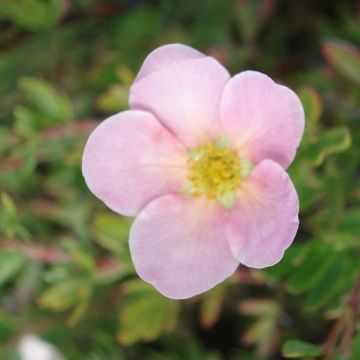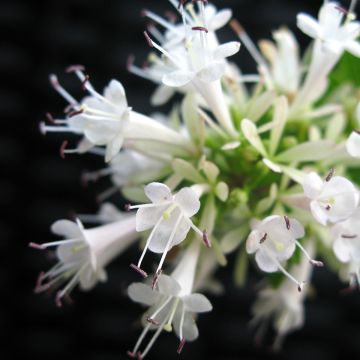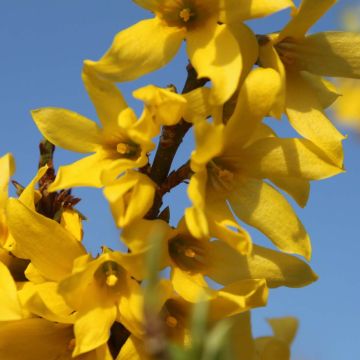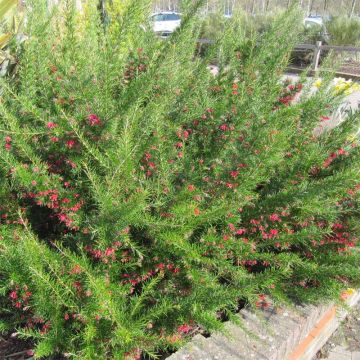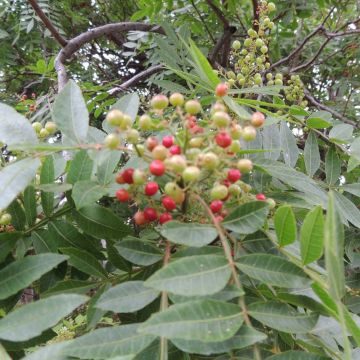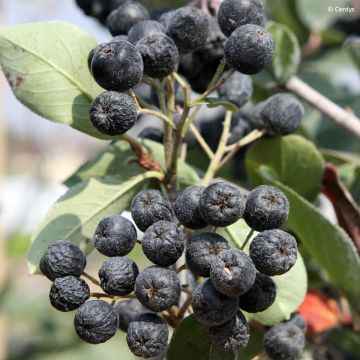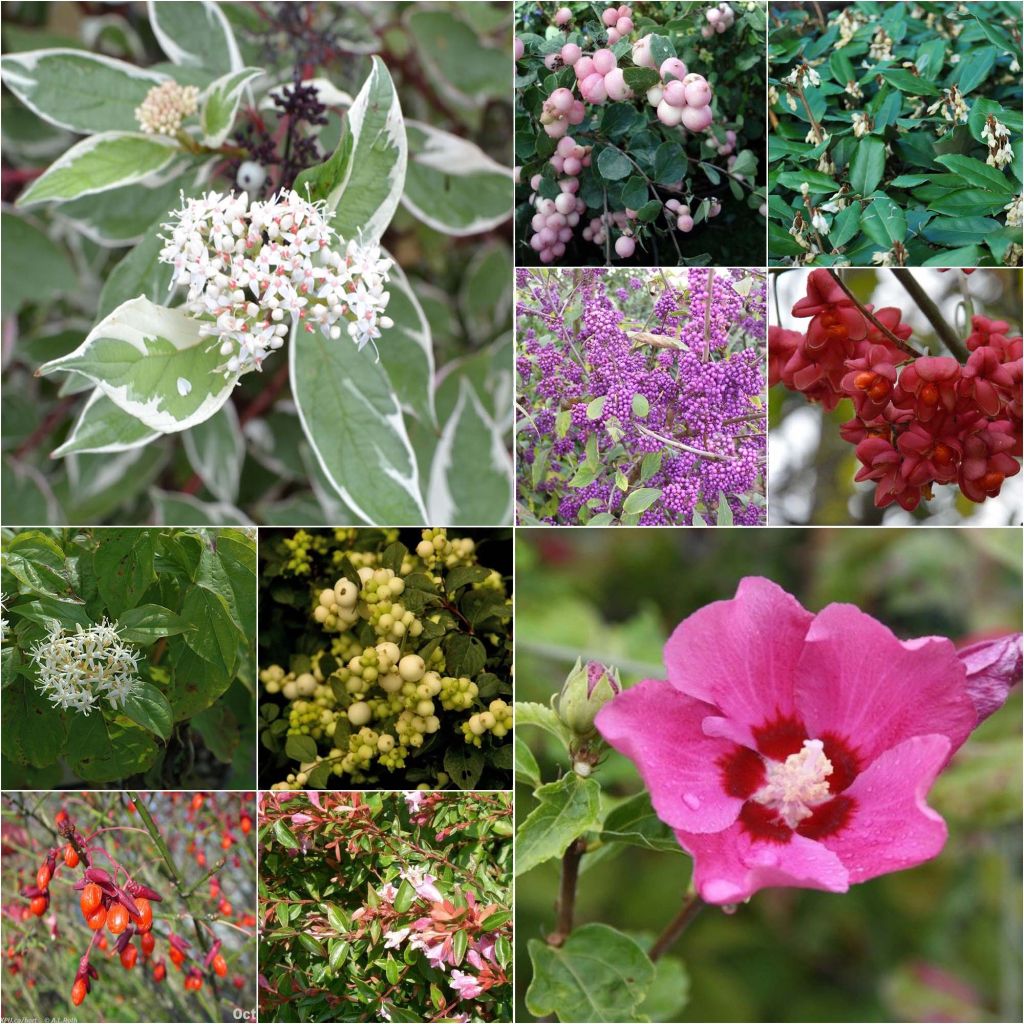

Autumn Flowering Eco Hedge Collection
Autumn Flowering Eco Hedge Collection
This plant carries a 24 months recovery warranty
More information
We guarantee the quality of our plants for a full growing cycle, and will replace at our expense any plant that fails to recover under normal climatic and planting conditions.
From €5.90 for pickup delivery and €6.90 for home delivery
Express home delivery from €8.90.
Does this plant fit my garden?
Set up your Plantfit profile →
Collection items (10 plants)
Description
This is a collection of 10 varieties of shrubs that we have selected for their flowers, fruits, or particularly interesting foliage in autumn. Easy to grow and hardy, requiring little maintenance, they are perfect for creating a sumptuous hedge at the end of the season that welcomes small wildlife in the garden. This hedge will also protect the garden from prying eyes and the wind throughout the summer season. Delivered as a kit of 10 plants in pots. This hedging kit allows you to create approximately 10 metres (33 feet) of hedge at a low cost.
The collection consists of:
- 1 Abelia Edward Goucher : approximately 1.75 m (6ft) in all directions, bushy from the base. Long flowering slightly scented, from July to late August (depending on the climate) until October, made up of small pearly white bells which are lilac pink on the opposite side. These are followed by rusty-coloured bracts which are very decorative in the autumn foliage. Small glossy leaves, semi-evergreen to evergreen depending on the severity of the winter, are light green in colour, turning bronze, violet, or reddish under the effect of the cold. It is resistant to approximately -15°C (5°F).
- 1 Callicarpa bodinieri Profusion : approximately 2.50 m (8ft) in height by 1.50 m (5ft) in width. It is seductive due to the abundance, and very bright violet colour, of its clusters of shiny fruits, decorative in autumn and for a good part of winter. It also displays numerous purple young shoots in spring, which are also very decorative, and its autumn foliage, orange to purple, is also very ornamental. Its deciduous foliage falls in October.
- 1 Cornus alba Elegantissima - White dogwood : approximately 2 m (7ft) in all directions. Its grey-green foliage is marginated and variegated with cream white and turns pink and yellow in autumn before falling, revealing its dark coral red branches. Cream white flowers appear in May-June, in small flat heads, followed by small round fruits with a bluish-white colour.
- 1 Cornus sanguinea Winter Beauty - Bloodtwig dogwood : approximately 2.50 m (8ft) in height by 1.20 m (4ft) in width. Deciduous foliage is absent in winter. Shiny young stems, almost fluorescent in winter are in shades of yellow, orange, and red. Its autumn foliage is another asset, in yellow to yellow-orange, sometimes slightly silver-tinted. Flowering in May-June is white and slightly fragrant and much appreciated by pollinating insects. Small round berries turn dark purple in summer.
- 1 Elaeagnus ebbingei - Oleaster : on average 3 m (10ft) tall by 1.50 m (5ft) wide. It is appreciated for the beauty of its silvery leaves, but also for its autumn flowering, with cream-white bell-shaped flowers with a sweet fragrance. Its fruits are edible and decorative, similar to small copper and silvery olives. Hardy to -15°C (5°F).
- 1 Euonymus alatus - Winged spindle tree: approximately 2 m (7ft) in all directions, slow-growing. Its four prominent and thin corky wings carry deciduous leaves, which change from medium green to pink, dark red, and brilliant purple in autumn before falling. Insignificant flowers of small white-greenish flowers give way to very decorative berries, dark purple-red, containing an orange seed.
- 1 Euonymus europaeus Red Cascade - European spindle tree : approximately 3 m (10ft) in height by 2 m (7ft) in width. The weight of its abundant bicoloured fruit, red and bright orange, arches and decorates its branches from the end of summer and a good part of winter. The foliage which is green, takes on an intense red colour from the first cool nights and truly ignites the shrub before falling.
- 1 Hibiscus syriacus Woodbridge - tree mallow : approximately 2.50 m (8ft) in height by 2 m (7ft) in width. A very long flowering period from August to October, with large single flowers in very bright colours, in pink and red, around a large white central column. Its deciduous foliage forms a dark, slightly glossy, beautiful setting. It appears late in spring and falls in November.
- 1 Symphoricarpus Mother of Pearl - Snowberry : approximately 1.50 m (5ft) in all directions. A profusion of pale pink berries, gathered in large very decorative clusters from August onwards. They remain decorative until January on the bare branches. Discreet summer flowering. The deciduous foliage, dark green in colour, takes on beautiful yellow tones in autumn before falling.
- 1 Symphoricarpus White Edge - Snowberry : approximately 1.50 m (5ft) in all directions. A profusion of white round berries like pearls, gathered in large very decorative clusters from August onwards. They remain decorative until January on the bare branches. The discreet summer flowering is white. The deciduous foliage, dark bluish-green in colour, takes on beautiful yellow tones in autumn before falling.
Plant these bushes preferably in autumn or early spring, in full sun or partial shade, mixing them and spacing them about 1 metre (3 feet) apart. They are content with any well-prepared garden soil, improved with leaf compost. Once well established, they do not require watering in summer.
Advice: Do not prune early in the season so you can fully enjoy the flowering! If possible, also avoid pruning in late summer to enjoy the fruits and feed the birds in the garden during winter.
Report an error about the product description
Plant habit
Flowering
Foliage
Botanical data
Cultivar or hybrid
Other Hedge-growing kits A to Z
Planting and care
Plant this collection in the sun or partial shade, in ordinary but well-prepared soil, enriched with leaf compost, that is rather moist but well-drained. Dig planting holes of 30-40 cm (12-16in) in all directions, thoroughly loosening the bottom and walls with a fork or pickaxe. Maintain a planting distance of 80 cm (32in) to 1 m (3ft) between each bush. Easy to grow and not very demanding, these shrubs only require mulching in summer in dry climates to maintain some moisture, at least during the first summers after planting. Water them abundantly in the first few years in the case of pronounced drought (15-20 litres of water each time), but keep waterings spaced out. You can prune the longest branches to help your shrubs branch out.
Planting period
Intended location
Care
This item has not been reviewed yet - be the first to leave a review about it.
Hedge shrubs
Haven't found what you were looking for?
Hardiness is the lowest winter temperature a plant can endure without suffering serious damage or even dying. However, hardiness is affected by location (a sheltered area, such as a patio), protection (winter cover) and soil type (hardiness is improved by well-drained soil).

Photo Sharing Terms & Conditions
In order to encourage gardeners to interact and share their experiences, Promesse de fleurs offers various media enabling content to be uploaded onto its Site - in particular via the ‘Photo sharing’ module.
The User agrees to refrain from:
- Posting any content that is illegal, prejudicial, insulting, racist, inciteful to hatred, revisionist, contrary to public decency, that infringes on privacy or on the privacy rights of third parties, in particular the publicity rights of persons and goods, intellectual property rights, or the right to privacy.
- Submitting content on behalf of a third party;
- Impersonate the identity of a third party and/or publish any personal information about a third party;
In general, the User undertakes to refrain from any unethical behaviour.
All Content (in particular text, comments, files, images, photos, videos, creative works, etc.), which may be subject to property or intellectual property rights, image or other private rights, shall remain the property of the User, subject to the limited rights granted by the terms of the licence granted by Promesse de fleurs as stated below. Users are at liberty to publish or not to publish such Content on the Site, notably via the ‘Photo Sharing’ facility, and accept that this Content shall be made public and freely accessible, notably on the Internet.
Users further acknowledge, undertake to have ,and guarantee that they hold all necessary rights and permissions to publish such material on the Site, in particular with regard to the legislation in force pertaining to any privacy, property, intellectual property, image, or contractual rights, or rights of any other nature. By publishing such Content on the Site, Users acknowledge accepting full liability as publishers of the Content within the meaning of the law, and grant Promesse de fleurs, free of charge, an inclusive, worldwide licence for the said Content for the entire duration of its publication, including all reproduction, representation, up/downloading, displaying, performing, transmission, and storage rights.
Users also grant permission for their name to be linked to the Content and accept that this link may not always be made available.
By engaging in posting material, Users consent to their Content becoming automatically accessible on the Internet, in particular on other sites and/or blogs and/or web pages of the Promesse de fleurs site, including in particular social pages and the Promesse de fleurs catalogue.
Users may secure the removal of entrusted content free of charge by issuing a simple request via our contact form.
The flowering period indicated on our website applies to countries and regions located in USDA zone 8 (France, the United Kingdom, Ireland, the Netherlands, etc.)
It will vary according to where you live:
- In zones 9 to 10 (Italy, Spain, Greece, etc.), flowering will occur about 2 to 4 weeks earlier.
- In zones 6 to 7 (Germany, Poland, Slovenia, and lower mountainous regions), flowering will be delayed by 2 to 3 weeks.
- In zone 5 (Central Europe, Scandinavia), blooming will be delayed by 3 to 5 weeks.
In temperate climates, pruning of spring-flowering shrubs (forsythia, spireas, etc.) should be done just after flowering.
Pruning of summer-flowering shrubs (Indian Lilac, Perovskia, etc.) can be done in winter or spring.
In cold regions as well as with frost-sensitive plants, avoid pruning too early when severe frosts may still occur.
The planting period indicated on our website applies to countries and regions located in USDA zone 8 (France, United Kingdom, Ireland, Netherlands).
It will vary according to where you live:
- In Mediterranean zones (Marseille, Madrid, Milan, etc.), autumn and winter are the best planting periods.
- In continental zones (Strasbourg, Munich, Vienna, etc.), delay planting by 2 to 3 weeks in spring and bring it forward by 2 to 4 weeks in autumn.
- In mountainous regions (the Alps, Pyrenees, Carpathians, etc.), it is best to plant in late spring (May-June) or late summer (August-September).
The harvesting period indicated on our website applies to countries and regions in USDA zone 8 (France, England, Ireland, the Netherlands).
In colder areas (Scandinavia, Poland, Austria...) fruit and vegetable harvests are likely to be delayed by 3-4 weeks.
In warmer areas (Italy, Spain, Greece, etc.), harvesting will probably take place earlier, depending on weather conditions.
The sowing periods indicated on our website apply to countries and regions within USDA Zone 8 (France, UK, Ireland, Netherlands).
In colder areas (Scandinavia, Poland, Austria...), delay any outdoor sowing by 3-4 weeks, or sow under glass.
In warmer climes (Italy, Spain, Greece, etc.), bring outdoor sowing forward by a few weeks.

































